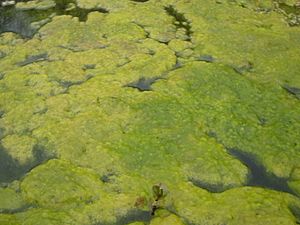Zygnematophyceae facts for kids
Quick facts for kids Zygnematophyceae |
|
|---|---|
 |
|
| Spirogyra green algae | |
| Scientific classification | |
| Kingdom: | |
| Division: | |
| Class: |
Zygnematophyceae
|
| Orders | |
|
Zygnematales |
|
Zygnematophyceae is a group of tiny living things called green algae. They are like very simple plants. This group includes two main types: Zygnematales and Desmidiales. You can find them almost everywhere there is fresh water.
Contents
What are Zygnematophyceae?
Zygnematophyceae are a special kind of green algae. They are known for their unique way of reproducing. Many of them look like long threads or chains of cells. Others are single cells with beautiful, symmetrical shapes. They are very important for life in ponds and lakes.
Where do they live?
These algae love fresh water. You can find them in many places. They live in ponds, lakes, and slow-moving rivers. They also grow in ditches and even on wet soil. They often form slimy green mats on the water's surface.
How do they look?
Zygnematophyceae come in different shapes.
- Filamentous algae: Some, like Spirogyra, look like long, green threads. These threads are made of many cells joined end-to-end. They feel slimy when you touch them.
- Desmids: Other types, called desmids, are single cells. They have amazing and beautiful shapes. Many desmids look like two mirror-image halves. They can be round, star-shaped, or even crescent-shaped.
The chloroplasts
Inside their cells, these algae have special parts called chloroplasts. Chloroplasts are where they make their own food using sunlight. In Spirogyra, the chloroplasts look like spiral ribbons. This is how Spirogyra got its name.
Reproduction and Life Cycle
One of the most interesting things about Zygnematophyceae is how they reproduce. They have a special method called conjugation.
What is conjugation?
Conjugation is a type of sexual reproduction. It happens when two algae cells join together.
- First, two nearby cells form a small tube between them.
- Then, the contents of one cell move through this tube into the other cell.
- The two cell contents mix and form a new, tougher cell called a zygospore.
- This zygospore can survive harsh conditions, like drying up or freezing.
- When conditions are good again, the zygospore grows into new algae.
This process helps them survive tough times. It also creates new combinations of genes.
Why are they important?
Zygnematophyceae play a big role in their ecosystems.
- Food source: They are a basic food source for many small water animals. These animals include tiny insects and crustaceans.
- Oxygen production: Like plants, they produce oxygen through photosynthesis. This oxygen is important for other living things in the water.
- Water quality: They can sometimes indicate the health of a water body. A lot of algae can mean there are too many nutrients in the water.
Examples of Zygnematophyceae
The two main groups are Zygnematales and Desmidiales.
Zygnematales
This group includes the filamentous algae.
- Spirogyra: This is one of the most common types. It forms long, unbranched threads. You can often see it floating in ponds.
- Mougeotia: Another filamentous alga. Its chloroplasts are flat plates inside the cell.
Desmidiales
This group includes the single-celled desmids. They are known for their beautiful and often symmetrical shapes.
- Closterium: These desmids are crescent-shaped.
- Micrasterias: These are very flat and look like a star or a snowflake. They have many lobes.
Images for kids
See also
 In Spanish: Algas conjugadas para niños
In Spanish: Algas conjugadas para niños


